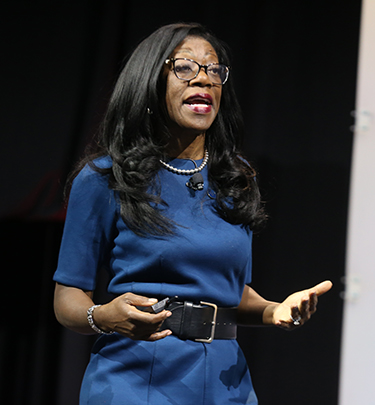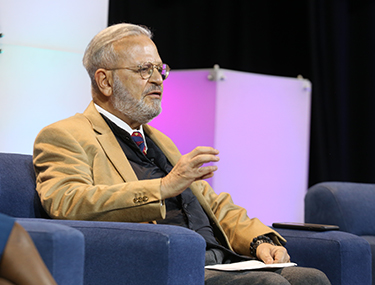Law professor Dayna Bowen Matthew implored APHA attendees to embrace the essential need for partnerships among science, medicine, education and the law to eradicate unjust discrimination in the U.S.
“Hear my clarion call for us to join together as public health, science and the law to fight for civil rights in each of the social determinants of health….Have the courage to identify structural racism as one of the primary causes — not only in theory, not only in data — but also to act upon it, to recognize that what we must do is partner together,” she said.

Bowen Matthew, dean and Harold H. Greene Professor of Law at George Washington University Law School, gave a keynote presentation before joining a panel discussion during Monday’s APHA General Session “We Dissent: Ensuring Equity in Public Health Education.”
In a short history lesson on civil rights and the law, Bowen Matthew outlined the powerful reforms brought about by the Reconstruction Era constitutional amendments — the 13th, 14th and 15th amendments that abolished slavery, granted equal rights to formerly enslaved people, and gave the right to vote to people of all races. She also pointed to Title VI of the Civil Rights Act of 1964, which protects people from discrimination based on race, color or national origin in programs or activities that receive federal financial assistance.
These laws should be taught not only in law schools, but also in medical schools and public health schools, she said.
“We can no longer educate physicians and clinicians and practitioners of science to think that they have nothing to do with civil rights. History tells us differently.”
One family’s story illustrates impacts of structural racism
Bowen Matthew cited data that showed that social and economic factors determine 40% of an individual’s health outcomes.
“If I don’t have safe street to walk on, if I don’t have tennis court nearby, if I have violence or my street, or if I’m working two swing shifts, I am not going to go out jogging at night to stay healthy,” she said.
Bowen Matthew illustrated the data more vividly with the story of her family: She is a Black woman who grew up in the South Bronx in New York City. Her father went to school at night, after his day job, earning a bachelor’s degree at the City College of New York. He then began commuting on the train into Manhattan for his new job as a real estate banker. After a full day of work, he came home, ate dinner, took a nap, and then went out again to work another job.
Between them, Bowen Matthew’s parents at one time worked six jobs to be able to afford the private school tuition for her and her brother. Her dad died at age 49. Her mother also died young, younger than Bowen Matthew is now.
“I share this because their story is so not unique. My parents died in part because of structural racism, because of what they had to do to make sure (I could get an education)….They died because they had to work enough jobs to afford the $4,000 so my brother and I could go (private school). That’s because of structural racism.”
Furthermore, Bowen Matthew said that all of her friends who went to her local public elementary at some point in adulthood were in jail or on drugs or they have died.
Bowen Matthew said that unjust discrimination characterizes every social determinant of health. “Think about it; think about my parents. The wages that they earned were because of discrimination. The school system that they tried to get me out of was because of discrimination.” She continued: The air she and her childhood neighbors breathed, as well as the water they drank and the food they ate, was because of “unjust discrimination,” she said.
“And as a result, the relationship between discrimination and law is imperative if we intend to create health equity.”
Affirmative action narrowed, but not dismantled
Bowen Matthew outlined the impact of the landmark 2023 U.S. Supreme Court decision Students for Fair Admissions v. Harvard, which held that colleges could not base admissions on race. However, despite what so many believe, the decision does not dismantle affirmative action, she said.
“That is one of the biggest misconceptions being perpetuated today. This decision severely narrowed affirmative action, but it in fact did not end affirmative action. I should say that it only ended it to the extent that we let it.”
During the panel discussion, pediatrician Ayman El-Mohandes, dean of the City University of New York Graduate School of Public Health and Health Policy, said the Supreme Court decision affects only admissions; it does not prohibit recruitment. Therefore, he called for schools of public health to quadruple efforts to recruit students from high-risk groups. He also favors doing away with standardized testing because they are racially biased.
the Supreme Court decision affects only admissions; it does not prohibit recruitment. Therefore, he called for schools of public health to quadruple efforts to recruit students from high-risk groups. He also favors doing away with standardized testing because they are racially biased.
He urged higher education to change the narrative: Admitting students from underrepresented groups enriches programs and the classroom experience for all students.
“We are not doing them a favor; they are doing us a favor,” he said.
He likes to remind his faculty “these students are coming in with a master’s degree already. You know what it is called? Life! They lived that experience.”
Laura King, executive director of the Council on Education for Public Health, said there are many ways schools can reduce barriers, such as eliminating prerequisite requirements and application fees. In addition, early-decision programs can be obstacles because they ask students to commit to a school before they know what their financial aid package looks like.
“Institutions can do a lot to eliminate barriers, or at least reduce barriers, as well as do affirmative work toward a diverse student body,” King said.
Photos: Dayna Bowen Matthew; Ayman El-Mohandes. Photos courtesy EZ Event Photography.